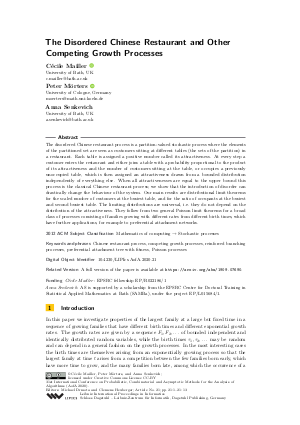The Disordered Chinese Restaurant and Other Competing Growth Processes
Authors
Cécile Mailler  ,
Peter Mörters
,
Peter Mörters  ,
Anna Senkevich
,
Anna Senkevich
-
Part of:
Volume:
31st International Conference on Probabilistic, Combinatorial and Asymptotic Methods for the Analysis of Algorithms (AofA 2020)
Part of: Series: Leibniz International Proceedings in Informatics (LIPIcs)
Part of: Conference: International Conference on Probabilistic, Combinatorial and Asymptotic Methods for the Analysis of Algorithms (AofA) - License:
 Creative Commons Attribution 3.0 Unported license
Creative Commons Attribution 3.0 Unported license
- Publication Date: 2020-06-10
File

PDF
LIPIcs.AofA.2020.21.pdf
- Filesize: 0.51 MB
- 13 pages
Document Identifiers
Related Versions
-
A full version of the paper is available at https://arxiv.org/abs/1909.07690.
Subject Classification
ACM Subject Classification
- Mathematics of computing → Stochastic processes
Keywords
- Chinese restaurant process
- competing growth processes
- reinforced branching processes
- preferential attachment tree with fitness
- Poisson processes
Metrics
- Access Statistics
-
Total Accesses (updated on a weekly basis)
0Document
0Metadata
Abstract
The disordered Chinese restaurant process is a partition-valued stochastic process where the elements of the partitioned set are seen as customers sitting at different tables (the sets of the partition) in a restaurant. Each table is assigned a positive number called its attractiveness. At every step a customer enters the restaurant and either joins a table with a probability proportional to the product of its attractiveness and the number of customers sitting at the table, or occupies a previously unoccupied table, which is then assigned an attractiveness drawn from a bounded distribution independently of everything else. When all attractivenesses are equal to the upper bound this process is the classical Chinese restaurant process; we show that the introduction of disorder can drastically change the behaviour of the system. Our main results are distributional limit theorems for the scaled number of customers at the busiest table, and for the ratio of occupants at the busiest and second busiest table. The limiting distributions are universal, i.e. they do not depend on the distribution of the attractiveness. They follow from two general Poisson limit theorems for a broad class of processes consisting of families growing with different rates from different birth times, which have further applications, for example to preferential attachment networks.
Cite As Get BibTex
Cécile Mailler, Peter Mörters, and Anna Senkevich. The Disordered Chinese Restaurant and Other Competing Growth Processes. In 31st International Conference on Probabilistic, Combinatorial and Asymptotic Methods for the Analysis of Algorithms (AofA 2020). Leibniz International Proceedings in Informatics (LIPIcs), Volume 159, pp. 21:1-21:13, Schloss Dagstuhl – Leibniz-Zentrum für Informatik (2020)
https://doi.org/10.4230/LIPIcs.AofA.2020.21
BibTex
@InProceedings{mailler_et_al:LIPIcs.AofA.2020.21,
author = {Mailler, C\'{e}cile and M\"{o}rters, Peter and Senkevich, Anna},
title = {{The Disordered Chinese Restaurant and Other Competing Growth Processes}},
booktitle = {31st International Conference on Probabilistic, Combinatorial and Asymptotic Methods for the Analysis of Algorithms (AofA 2020)},
pages = {21:1--21:13},
series = {Leibniz International Proceedings in Informatics (LIPIcs)},
ISBN = {978-3-95977-147-4},
ISSN = {1868-8969},
year = {2020},
volume = {159},
editor = {Drmota, Michael and Heuberger, Clemens},
publisher = {Schloss Dagstuhl -- Leibniz-Zentrum f{\"u}r Informatik},
address = {Dagstuhl, Germany},
URL = {https://drops.dagstuhl.de/entities/document/10.4230/LIPIcs.AofA.2020.21},
URN = {urn:nbn:de:0030-drops-120511},
doi = {10.4230/LIPIcs.AofA.2020.21},
annote = {Keywords: Chinese restaurant process, competing growth processes, reinforced branching processes, preferential attachment tree with fitness, Poisson processes}
}
Author Details
Funding
- Mailler, Cécile: EPSRC fellowship EP/R022186/1
- Senkevich, Anna: AS is supported by a scholarship from the EPSRC Centre for Doctoral Training in Statistical Applied Mathematics at Bath (SAMBa), under the project EP/L015684/1.
References
-
G. Bianconi and A.-L. Barabási. Bose-Einstein condensation in complex networks. Physical Review Letters, 86:5632-5635, 2001.

-
S. Dereich. Preferential attachment with fitness: Unfolding the condensate. Electronic Journal of Probability, 21:38pp., 2016.

-
S. Dereich, C. Mailler, and P. Mörters. Non-extensive condensation in reinforced branching processes. Annals of Applied Probability, 27:2539-2568, 2017.

-
S. Dereich and M. Ortgiese. Robust analysis of preferential attachment models with fitness. Combinatorics, Probability and Computing, 23:386–411, 2014.

- C. Mailler, P. Mörters, and A. Senkevich. Competing growth processes with random growth rates and random birth times. arXiv preprint, 2019. URL: http://arxiv.org/abs/1909.07690.
-
O. Nerman. On the convergence of supercritical general (C-M-J) branching processes. Z. Wahrscheinlichkeitstheorie verw. Gebiete, 57:365-395, 1981.

-
P. Olofsson. General branching processes with immigration. Journal of Applied Probability, 33:940-948, 1996.

-
S. Resnick. Extreme values, regular variation, and point processes. Springer-Verlag, 1987.

-
A. Senkevich. Competing growth processes with applications to networks. PhD thesis, University of Bath, 2019.

-
X. Tang and C. C. Yang. Dynamic community detection with temporal Dirichlet process. In 2011 IEEE Third Int, pages 603-608, 2011.

